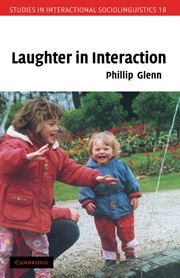Book contents
- Frontmatter
- Contents
- List of figures and tables
- Acknowledgments
- Transcription symbols
- Introduction
- 1 Towards a social interactional approach to laughter
- 2 Conversation analysis and the study of laughter
- 3 Laughing together
- 4 Who laughs first
- 5 Laughing at and laughing with: negotiating participant alignments
- 6 Laughing along, resisting: constituting relationship and identity
- 7 Closing remarks
- Notes
- References
- Index
Introduction
Published online by Cambridge University Press: 08 August 2009
- Frontmatter
- Contents
- List of figures and tables
- Acknowledgments
- Transcription symbols
- Introduction
- 1 Towards a social interactional approach to laughter
- 2 Conversation analysis and the study of laughter
- 3 Laughing together
- 4 Who laughs first
- 5 Laughing at and laughing with: negotiating participant alignments
- 6 Laughing along, resisting: constituting relationship and identity
- 7 Closing remarks
- Notes
- References
- Index
Summary
Those who attempt scholarly works about laughter or humor often begin with an apology responding to one of two sorts of complaints. The first is that laughter is trivial, unimportant, associated with children and with momentary diversions from the more serious, important business of (adult) human life; therefore, it hardly seems worth serious scholarly investigation. The second is that, even if one grants the potential importance of studying laughter, one kills the joy in the subject matter by analyzing something so natural and spontaneous, perhaps akin to dissecting fish in an attempt to understand the way they swim in streams. I will not begin this book by making such apologies. The defenses they might generate, however, are worth noting. Briefly, for those who might wonder, the following assertions underlie this study of human laughter in interaction. In its ability to display affiliation, friendliness, or even intimacy, laughter plays an important role in the creation and maintenance of interpersonal relationships. It can also serve to mock, deride, and belittle others, when it is the laughter of cruelty and triumph. We laugh accompanying and responsive to all sorts of talk and actions: often but not always as a response to humor, but also when we feel nervous or simply when others are laughing. Laughter has been part of the human communicative repertoire for a very long time, probably even predating speech, and our higher primate cousins also enact behaviors that look and sound like laughter and serve similar purposes.
- Type
- Chapter
- Information
- Laughter in Interaction , pp. 1 - 6Publisher: Cambridge University PressPrint publication year: 2003



